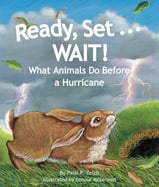Alignment to Standards for DC

| Grade | Number | Standard |
|---|---|---|
| 1 | SC.1.2.1. | Recognize and explain that water, rocks, soil, and living organisms are found on the Earths surface. |
| 1 | SC.1.4. | Different types of plants and animals inhabit the Earth. |
| 2 | G 2.1.1. | Understand how maps and globes depict geographical information in different ways. (G) |
| 2 | SC.2.3.2. | Explain that air temperature, humidity, wind speed and direction, and precipitation make up the weather in a particular place and time. |
| 2 | SC.2.3.5. | Explain the difference between weather and climate. |
| 2 | SC.2.3.6. | Describe the differences among the various forms of precipitation (rain, snow, sleet, and hail). |
| 2 | SC.2.3.7. | Cite specific examples of how human beings protect themselves from adverse weather conditions through different means. |
| 2 | SC.2.6. | Plants and animals have structures that serve different functions in growth, survival, and reproduction. |
| 2 | SC.2.6.1. | visible, external features of plants and animals and describe how these features help them live in different environments. |
| 2 | SC.2.7.1. | Observe and describe how animals may use plants, or even other animals, for shelter and nesting. |
| 2 | SC.2.7.4. | materials in nature, such as grass, twigs, sticks, and leaves, can be recycled and used again, sometimes in different forms, as birds do in making their nests. |
| 2 | SC.2.8. | Many different types of plants and animals inhabit the Earth. |
| 3 | SC.3.5.1. | living things can be sorted into groups in many ways using various properties, such as how they look, where they live, and how they act, in order to decide which things belong to which group. |
| 3 | SC.3.7.4. | Recognize that food provides energy as well as materials for growth, maintenance, and repair of body parts. |
| 4 | SC.4.3.1. | Explain how waves, wind, water, and glacial ice shape and reshape Earthês land surface by eroding rock and soil in some areas and depositing them in other areas. |
| 4 | SC.4.3.2. | Explain how the surface of the Earth changes over various time scales due to processes, such as erosion and weathering, landslides, volcanic eruptions, earthquakes, and mountain building. |
| 4 | SC.4.7.1. | Explain that organisms interact with one another in various ways, such as providing food, pollination, and seed dispersal. |
| 5 | SC.5.4.4. | Explain that the air around us is matter and has weight (a force) and exerts pressure; explain that air pressure varies a little from place to place and from time to time. |
| 5 | SC.5.4.6. | Explain how global patterns, such as the jet stream and ocean currents, influence local weather and climate in ways that can be measured in terms of temperature, pressure, wind direction and speed, and amounts of precipitation. |
| 5 | SC.5.6.1. | objects can move with a very wide range of speeds, with some moving very slowly and some moving too quickly for people to see them. |
| 5 | SC.5.8. | Many characteristics of an organism are inherited from the parents, but others result from the influence of the environment. |
| 5 | SC.5.8.2. | List some characteristics of plants and animals that are fully inherited (e.g., form of flower, shape of leaves) and others that are affected by the climate or environmental conditions (e.g., browning of leaves from too much sun, language spoken). |
| 5 | SC.5.9. | Adaptations in physical structure or behavior may improve an organismês chance for survival. |
| 5 | SC.5.9.7. | Recognize that some behaviors are instinctive (turtles burying their eggs) and others learned (wolfês hunting skills). |
| K | G K.1. 2. | Demonstrate familiarity with what a map is and what a globe is. (G) |
| K-2 | G K-2.1. | Students use map and globe skills to determine the locations of places. |